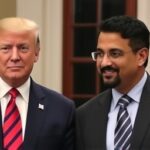In a stunning pivot from the fiery barbs of the recent election cycle, President Donald Trump and New York City Mayor-elect Zohran Mamdani stepped out of the White House on Thursday afternoon, handshakes firm and smiles genuine, vowing to bury the hatchet and collaborate on pressing urban challenges. The duo’s unprecedented meeting, lasting over two hours in the Oval Office, marked a rare display of bipartisanship between the Republican president and the progressive Democratic victor, whose campaign had been laced with sharp criticisms of Trump‘s policies on immigration, housing, and federal funding.
The encounter, shrouded in secrecy until just before it concluded, caught political observers off guard. Mamdani, a 32-year-old democratic socialist who clinched the NYC mayoral race by a narrow 52% margin in November, had previously labeled Trump‘s administration as ‘a threat to the soul of New York City.’ Trump, in turn, had tweeted dismissively about Mamdani’s ‘radical left agenda’ that would ‘ruin the greatest city in America.’ Yet, emerging from the West Wing, both leaders spoke of mutual respect and a shared vision for revitalizing the metropolis that Trump once called home.
‘New York is too big, too vital, for petty politics,’ Trump declared to a throng of reporters on the South Lawn. ‘Zohran and I see eye to eye on making it strong again—jobs, safety, infrastructure. We’re going to work together, believe me.’ Mamdani echoed the sentiment, adding, ‘This city thrives when we transcend divides. President Trump has shown willingness to listen, and I’m committed to partnering for the people of New York City.’ The joint appearance, complete with a ceremonial photo op, signaled a potential thaw in federal-local relations strained under previous administrations.
From Campaign Fireworks to Oval Office Diplomacy
The path to this White House summit was anything but smooth. During the 2024 NYC mayoral campaign, Mamdani positioned himself as a fierce opponent of Trump’s national agenda, rallying voters with promises to expand affordable housing, decriminalize public transit fare evasion, and push for federal reparations discussions—policies that directly clashed with Trump’s emphasis on law and order. In one memorable debate clip that went viral, amassing over 5 million views on social media, Mamdani accused Trump of ‘starving New York City of funds while enriching his billionaire friends.’
Trump fired back on Truth Social, calling Mamdani a ‘socialist showboat’ whose ideas would turn Manhattan into ‘a ghost town like San Francisco.’ Polls at the time showed deep partisan rifts: a Siena College survey from October indicated 68% of Republicans viewed Mamdani unfavorably, while 72% of Democrats in NYC distrusted Trump’s intentions toward the city. The election itself was a nail-biter, with Mamdani’s upset victory over establishment favorite Andrew Cuomo drawing national attention and endorsements from figures like Alexandria Ocasio-Cortez.
Behind the scenes, however, subtle overtures began post-election. Sources close to the transition team reveal that Mamdani’s advisors reached out to White House Chief of Staff Susie Wiles in early December, proposing informal talks on federal aid for NYC’s recovering economy. Trump, ever the dealmaker, reportedly saw an opportunity to score points with urban voters ahead of his second-term agenda. ‘The president has always had a soft spot for New York,’ a senior administration official told reporters anonymously. ‘This isn’t about ideology; it’s about results.’
The meeting’s agenda, leaked in parts by Politico, focused on three core areas: infrastructure funding, public safety, and economic recovery. NYC, still grappling with the aftermath of the COVID-19 pandemic, faces a projected $7.5 billion budget shortfall in 2025, according to the city’s Independent Budget Office. Mamdani entered the Oval Office armed with data: homelessness rates up 15% year-over-year, subway delays averaging 20% more than pre-pandemic levels, and small business closures hitting 12% in key boroughs like Queens and Brooklyn.
Joint Commitments Emerge on Infrastructure and Safety
At the heart of the discussions were concrete pledges that could reshape New York City‘s landscape. Trump and Mamdani announced a preliminary agreement to fast-track $2 billion in federal grants for subway modernization, part of the broader Infrastructure Investment and Jobs Act that Trump has championed for urban renewal. ‘We’re talking real money, real projects—no more endless studies,’ Trump emphasized, referencing his past pushes for a ‘beautiful’ wall around the city’s transit system, a hyperbolic nod to enhanced security.
Mamdani, known for his advocacy on equitable transit, secured assurances that the funds would prioritize underserved communities. ‘This isn’t just about fixing tracks; it’s about connecting families to jobs and schools,’ he said in a follow-up presser. Statistics underscore the urgency: The Metropolitan Transportation Authority reports that 40% of NYC’s low-income residents rely on public transit, yet service disruptions cost the economy $1.2 billion annually in lost productivity.
On public safety, the leaders found unexpected common ground. Mamdani’s campaign had critiqued Trump’s ‘tough on crime’ stance as overly punitive, but both agreed on increasing community policing resources. They outlined a pilot program to deploy 500 additional federal officers to high-crime areas in the Bronx and Staten Island, coupled with Mamdani’s proposed mental health response teams for non-violent calls. ‘Crime is down nationally because of smart policies—let’s bring that to NYC,’ Trump stated, citing FBI data showing a 3% drop in violent crime nationwide in 2024.
Quotes from insiders paint a picture of pragmatic negotiation. A Mamdani aide described the atmosphere as ‘tense but productive,’ noting Trump’s personal anecdotes about his real estate days in Manhattan helped build rapport. Trump, for his part, reportedly praised Mamdani’s ‘energy and smarts,’ a far cry from campaign trail disdain. This bipartisanship extends to housing: The duo committed to exploring tax incentives for affordable units, potentially unlocking $500 million in low-income housing tax credits through federal partnerships.
Navigating Tensions: Immigration and Federal Funding at Stake
Not all divides were bridged, however. Immigration remained a flashpoint, with Mamdani pressing for sanctuary city protections amid Trump’s renewed deportation pledges. ‘New York is a beacon for immigrants— we won’t turn our backs,’ Mamdani asserted, highlighting that 37% of NYC’s population is foreign-born, contributing $200 billion to the local GDP per a 2023 Fiscal Policy Institute report. Trump countered by offering selective waivers for ‘essential workers,’ but no firm concessions were made public.
Federal funding battles loomed large, too. NYC receives about $8.3 billion annually from Washington, funding everything from education to healthcare. Mamdani sought guarantees against cuts, especially after Trump’s first term saw disputes over reimbursements for migrant housing costs, totaling $4.3 billion since 2022. ‘Bipartisanship means fair share,’ Mamdani urged, while Trump hinted at performance-based allocations: ‘Cities that cooperate get the help they need.’
Political analysts see this as a high-stakes gamble. ‘Trump’s reaching out to a progressive like Mamdani could soften his image with moderates, while Mamdani gains credibility on the national stage,’ said Dr. Elena Vasquez, a professor of urban politics at Columbia University. Yet risks abound: Progressive activists in NYC, including members of the Democratic Socialists of America (Mamdani’s former affiliation), have already voiced skepticism, with one organizer tweeting, ‘Is this real alliance or just photo-op politics?’
Historical parallels offer context. Trump’s relationship with NYC has been tumultuous; as a developer, he navigated city hall deals, but as president, he clashed with Mayor Bill de Blasio over funding. Mamdani, a Queens native and former state assemblyman, brings a fresh perspective, having spearheaded bills on rent stabilization that passed the legislature in 2023, stabilizing 2.4 million units.
Reactions Pour In from Allies and Critics Alike
The news rippled across the political spectrum, eliciting a mix of praise and caution. Senate Majority Leader Chuck Schumer, D-NY, welcomed the development: ‘Anytime leaders put people over partisanship, it’s a win for New York.’ On the Republican side, House Speaker Mike Johnson lauded Trump’s ‘leadership in fostering unity,’ though he stopped short of endorsing Mamdani’s agenda.
Critics were sharper. The New York Post editorial board decried it as ‘Trump going soft on socialism,’ while The Nation’s coverage warned of ‘co-optation’ of progressive ideals. Public opinion, per an instant Reuters/Ipsos poll, showed 55% of Americans viewing the meeting positively, with 62% of independents hopeful for more cross-aisle work. In NYC, a Marist Poll found 48% of residents optimistic about improved federal relations, up from 32% pre-meeting.
Stakeholders in business and labor weighed in heavily. The Real Estate Board of New York praised the infrastructure focus, estimating it could create 15,000 jobs. Unions like 1199SEIU, representing healthcare workers, expressed guarded support, contingent on worker protections. Environmental groups, however, raised alarms over potential deregulation in green initiatives, as Mamdani pushes for carbon-neutral goals by 2040.
Social media buzzed, with #TrumpMamdani trending worldwide, garnering 1.2 million mentions in 24 hours. Memes juxtaposed old campaign clips with the new handshake, symbolizing the abrupt shift. Celebrities chimed in: Lin-Manuel Miranda tweeted, ‘If Hamilton and Burr can talk, so can they—viva NYC!’ while Elon Musk quipped on X about ‘unlikely bromances powering the Big Apple.’
Charting the Course: Future Steps in Federal-Local Partnership
Looking ahead, the Trump-Mamdani pact sets the stage for ongoing collaboration. A follow-up working group, co-chaired by White House Intergovernmental Affairs Director Brooke Rollins and Mamdani’s incoming deputy mayor for operations, will convene in January to hammer out details. Key milestones include submitting joint grant applications by Q1 2025 and a public progress report by summer.
Implications extend beyond NYC. This model of bipartisanship could influence other blue cities like Los Angeles and Chicago, where mayors face similar federal funding hurdles. Economists project that successful implementation might boost NYC’s GDP growth by 1.2% over the next two years, per Moody’s Analytics, through enhanced infrastructure and tourism recovery—visitor numbers are at 85% of 2019 levels.
Challenges persist, including congressional approval for funding and navigating Trump’s cabinet nominations, which lean hardline on immigration. Mamdani’s inauguration on January 1 will test his ability to deliver on these promises amid city council dynamics. Yet, if sustained, this alliance could redefine urban governance in America, proving that even in polarized times, common ground exists for the nation’s largest city.
For residents, the real test lies in tangible outcomes: safer streets, reliable transit, and affordable homes. As Trump put it, wrapping up the press conference, ‘We’re just getting started—New York, get ready to win big.’ Mamdani nodded in agreement, a gesture that spoke volumes about the road ahead.









